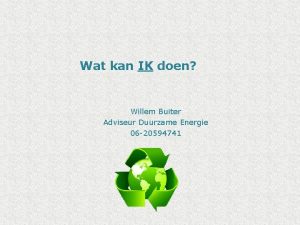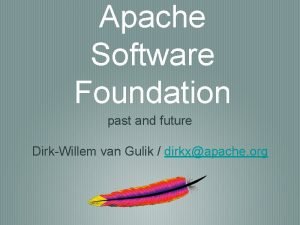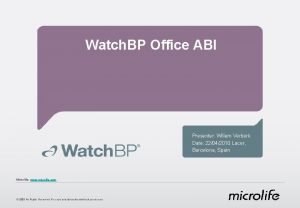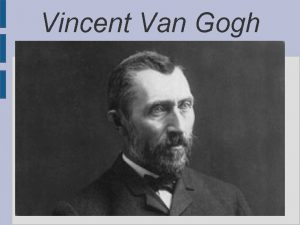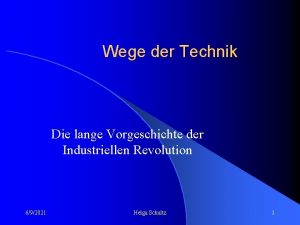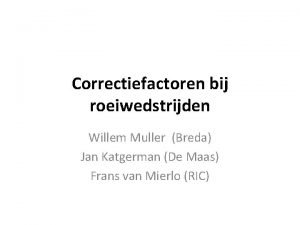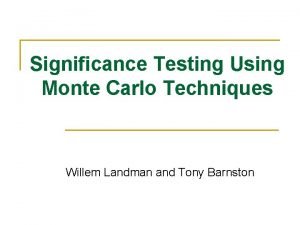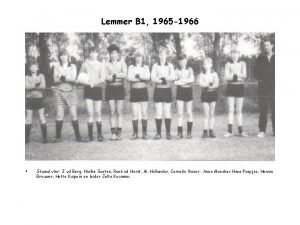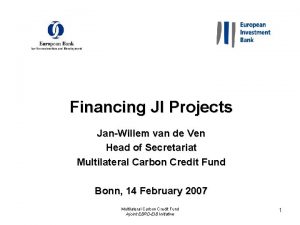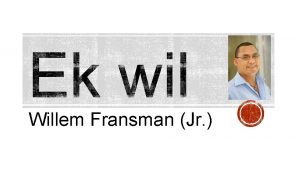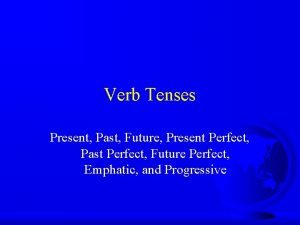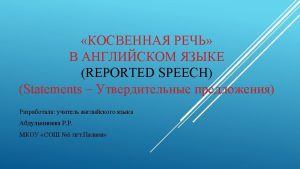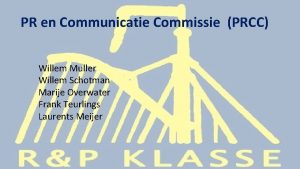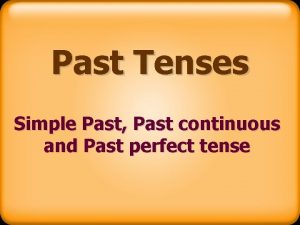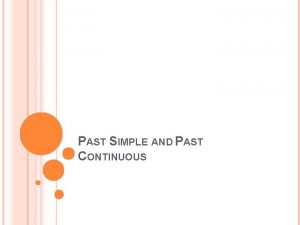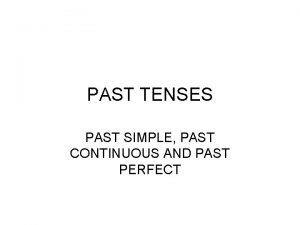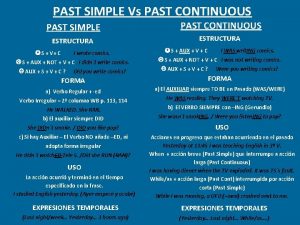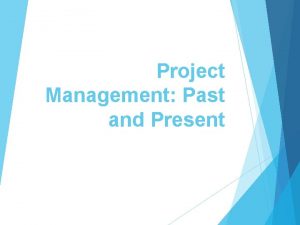Marine Management Systems past present and future Willem































- Slides: 31

Marine Management Systems past, present and future. Willem Pols Manager Marine Management Systems Office Middle East & Africa Marine Management Systems Office LLOYD’S REGISTER EMEA

Marine management systems • Background and needs. • Systems available and suitable. • Future management systems. Marine Management Systems Office LLOYD’S REGISTER EMEA

Background and needs • Why do we need all this extra work ? • We have more then enough papers ? • Our business is shipping not administration. Marine Management Systems Office LLOYD’S REGISTER EMEA

Background and needs • Vessels are usually subcontracted. • Subcontractors are demanding partners. • They don’t want to be looking after you. • Some kind of management system is your way to show compliance and commitment. Marine Management Systems Office LLOYD’S REGISTER EMEA

Marine management systems • At present most of the shipping companies have something in place. • • The ones with vessels >500 GRT have ISM. Usually ISO 9001: 2000 (QMS). More matures have ISO 14000 (EMS). Top of the range have ISO 18000 (OHSAS). • Nowadays more and more based on risk assessments and take into consideration human element. Marine Management Systems Office LLOYD’S REGISTER EMEA

Marine management systems • BUT ARE THEY EFFECTIVE ? Marine Management Systems Office LLOYD’S REGISTER EMEA

Key elements management systems • The policy and objectives. • The identification, allocation and organisation of resources, including the definition of responsibilities, authorities and interrelations. Improve Plan • The systematic planning and control of activities in order to achieve the elimination or reduction of risk. • The maintenance and continual improvement of the system. Measure • Risk assessments. Marine Management Systems Office LLOYD’S REGISTER EMEA Do

ISO 9001 Quality Management System (QMS) • Framework for all management systems. • Is all about processes KPIs and not about products. • Is general and suitable for all organisations. • Most important thing is continual improvement. • Customer focus and satisfaction. • Analysis of data. Marine Management Systems Office LLOYD’S REGISTER EMEA

Environmental Management System ISO 14000 Marine Management Systems Office LLOYD’S REGISTER EMEA

Environmental Management System (EMS) • Management system with the main drivers are environmental issues. • Ships included as well. • A large number of documents and procedures needed. • Hard to keep up with, and maintain for workboats. • KPIs are all about prevention and reduction of pollution. • Is a very dynamic system which needs reviewing all the time. Marine Management Systems Office LLOYD’S REGISTER EMEA

EMS advantages • Cost: avoidance of fines; identification of possible areas which can save costs such as recycling, bunker and other energy. • Marketing: use as competitive advantage, improve PR. • Training: increased production rate, reduce potential for environmental incidents through contingency awareness. • Monitoring: Identified harmful substances outside of the process. • Management: Complete other quality standards, help anticipate future legislation, better relations with regulatory and licensing authorisations. Marine Management Systems Office LLOYD’S REGISTER EMEA

OHSAS 18000 (occupational health and safety assessment series) • Many similarity with EMS, same structure but then for safety. • If you look at it, very difficult for the shipping industry. • More paperwork due to leglislations to comply with. (less ballast) • Difficult to combine with ISM and other systems, due to changes needed all the time. • More training is necessary and follow up needed. • Many shipping companies are already on the road but are struggling. Marine Management Systems Office LLOYD’S REGISTER EMEA

ISM (international safety management code) • For vessels < 500 grt voluntary ISM possible. • At the moment very popular for workboats and supply vessels. • ISM requires managers to maintain a safety management system, but there is only an implicit requirement for procedures. • This is a safety management system which manages the risks on vessels. • Easy to combine with “office” systems like ISO 9001: 2000. Marine Management Systems Office LLOYD’S REGISTER EMEA

Risk management in the shipping industry • What is risk ? • What are the consequences ? • A prescriptive approach to risk management. • A risk-based approach to risk management. Shipping companies are somewhere in between. Marine Management Systems Office LLOYD’S REGISTER EMEA

What is risk ? Risk is: • The chance of an adverse event. • The likelihood of a hazard being realised. • The combination of the probability, or frequency of occurrence of a defined hazard and the magnitude of the consequences of the occurrence (BS 4778). Marine Management Systems Office LLOYD’S REGISTER EMEA

Risk Assessment in simple terms So Lloyd’s Register Surveyors will understand it. • What can go wrong ? • How likely is it to go wrong ? • What happens if it does go wrong ? • Does it matter ? • What do we do if it does go wrong? • Prevent it happening. • Reduce its frequency. • Mitigate its consequences. OHSAS is designed for this Marine Management Systems Office LLOYD’S REGISTER EMEA

What is risk? • Risk is therefore a measure of the likelihood of a specific undesired event and its unwanted consequences or loss Risk to health and safety Risk to environment Cost Risk of operations Marine Management Systems Office LLOYD’S REGISTER EMEA

Managing the risks • Procedures within the manuals and systems on the vessels. • (Voluntary) Safety management systems. • A prescriptive approach. - Hot working permit. Towing checklist. Enclosed space entry permit on barges. Local rules and regulations. Marine Management Systems Office LLOYD’S REGISTER EMEA

Transporting containers Marine Management Systems Office LLOYD’S REGISTER EMEA

Example of risk assessment containers Marine Management Systems Office LLOYD’S REGISTER EMEA

What will be the future management systems for shipping ? • They will all be based on pro-active risk assessments focused on human elements. • Shipping companies have combined QMS for the offices and ISM for their vessels. • Common sense is documented to show compliance (voluntary ISM). Marine Management Systems Office LLOYD’S REGISTER EMEA

How do we get there ………? Marine Management Systems Office LLOYD’S REGISTER EMEA

Gap analysis to be carried out Marine Management Systems Office LLOYD’S REGISTER EMEA

PRISM(arine) • Progressive Route Into System Management. • Six step approach to go from start to next management system. Usually ISO 14000 or OHSAS. • Start might be ISO 9001: 2000 or ISM (PRISMarine). • After successful completing a stage Statement of Compliance. • Implementation is nice and easy, actually it is • DO IT YOUR SELF MANAGEMENT SYSTEMS Marine Management Systems Office LLOYD’S REGISTER EMEA

Six steps from PRISM(arine) 1. Business commitment. 2. System Design. 3. Risk Identification, Policy & Objectives. 4. System documentation. 5. Control of risk. 6. Audit, review and improvement. Marine Management Systems Office LLOYD’S REGISTER EMEA

Human Element Gap Analysis (HEGA) What? Diagnostic interviews to gather data on company management of the human element and compare this to the levels in the ‘Best Practice Guide’. Why? Enable resources to be better focused to areas where they are most required. Benefit? Attract & retain quality seafarers. Enhance safety & quality. Marine Management Systems Office LLOYD’S REGISTER EMEA

Areas of best practice in addressing the human element Marine Management Systems Office LLOYD’S REGISTER EMEA

HE 1 Management commitment to human element HE 2 Integrating management and use of HE data HE 3 Integration into the strategy HE 4 Crew input HE 5 Value for money decisions HE 6 Decision making HE 7 Current operations – in-service ships HE 8 Starting an operation HE 9 Repair and modification HE 10 Laying up and selling on HE 11 Design and build Marine Management Systems Office LLOYD’S REGISTER EMEA Level 1 Reactive Level 2 Proactive Level 3 Managed Level 4 Optimised Human element capability profile

Shipping in Pakistan in 2012 For example we have assistance in dredging operation. • Normal standard instructions according ISM & QMS. • Risk assessment to be undertaken into consideration. - Environmental impact on this operation (soil dripping, heat, waste from the pipeline room, start up operation). - Health & Safety Aspects (falling, working in the heat, tools to be used, protective measurements in place). - HE (start with a meeting, assess who is willing to do the job, consider the experience, rest hours, competency, evaluate and best practice to communicate). Marine Management Systems Office LLOYD’S REGISTER EMEA

Shipping in Pakistan in 2012 • Be happy • Enjoy your life and your job • USE YOUR COMMON SENSE Marine Management Systems Office LLOYD’S REGISTER EMEA

For more information, please contact: Lloyd’s Register Middle East Area Attn: Willem Pols P. O. Box 8935 Festival Office Tower, Suite 2001 Dubai T: +971(0)47014190 Services are provided by members of the Lloyd’s Register Group Lloyd’s Register, Lloyd’s Register EMEA and Lloyd’s Register Asia are exempt E: MMSO-MEA@lr. org charities under the UK Charities Act 1993. Marine Management Systems Office LLOYD’S REGISTER EMEA The Lloyd’s Register Group works to enhance safety and approve assets and systems at sea, on land in the air – because life matters.
 Present simple present continuous past simple exercises
Present simple present continuous past simple exercises Present simple present continuous past simple future simple
Present simple present continuous past simple future simple Present simple, past simple, future simple
Present simple, past simple, future simple Simple present simple past simple future exercises
Simple present simple past simple future exercises Future perfect future continuous exercises
Future perfect future continuous exercises Future perfect continuous and simple
Future perfect continuous and simple Past perfect continuous and past simple
Past perfect continuous and past simple Willem buiter energie
Willem buiter energie Zitno polje sa vranama
Zitno polje sa vranama Kehinde wiley barack obama
Kehinde wiley barack obama Avond willem kloos
Avond willem kloos Dirk-willem van gulik
Dirk-willem van gulik De veraders
De veraders Willem verberk
Willem verberk Vincent willem van gogh
Vincent willem van gogh Willem j kolff
Willem j kolff Willem van aelst
Willem van aelst Participatory technology development
Participatory technology development Mercedes rit in die aand
Mercedes rit in die aand Democratisering van nederland 1848 tot 1919
Democratisering van nederland 1848 tot 1919 Jan katgerman
Jan katgerman Sorrowing old man painting
Sorrowing old man painting Carlo_nnn
Carlo_nnn Willem wassenaar lemmer
Willem wassenaar lemmer Grotecup lemmer
Grotecup lemmer De kooning technique
De kooning technique Willem foorthuis
Willem foorthuis Eindrijm voorbeelden
Eindrijm voorbeelden Jan-willem van de ven
Jan-willem van de ven Jan willem bode
Jan willem bode Vera giebels
Vera giebels Present past continuous
Present past continuous







